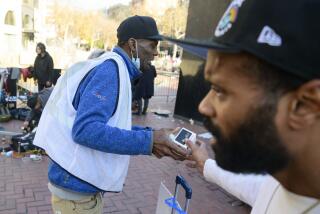Sounding the alarm as prescription drug abusers turn to heroin
- Share via
Standing in the pulpit above Austin Klimusko’s casket three years ago, his mother used his death to draw the connection between pills from a pharmacy and drugs from the street.
“When his prescriptions dried up, he turned to heroin,” Susan Klimusko said in a frank eulogy meant as a warning to the young mourners at Simi Valley’s Cornerstone Church.
Last week, the nation’s top public health official used the bully pulpit to sound the same alarm. The prescription drug epidemic is stoking the nation’s appetite for heroin with disastrous results, Dr. Tom Frieden, director of the U.S. Centers for Disease Control and Prevention, told reporters in a teleconference.
“We are priming people to addiction to heroin with overuse of prescription opiates, which are, after all, essentially the same chemical with the same impact on the brain,” he said.
Frieden made his comments as he announced that heroin use had increased 62% and related deaths had nearly quadrupled since 2002.
The biggest increases were among groups associated with a parallel rise in the use of prescription painkillers, such as OxyContin and Vicodin. Today’s heroin user is increasingly likely to be wealthy, privately insured and between the ages of 18 and 25, according to the study by researchers at the CDC and the U.S. Food and Drug Administration.
It is a phenomenon familiar to people on the front lines of the crisis from Simi Valley to San Diego.
“The face of the heroin addict has changed very much to that of an 18- to 25-year-old surfer kind of guy,” said Susan Bower, a San Diego County health official who noted the shift there a few years ago.
And the prescription painkiller has become the new gateway drug to heroin use, eclipsing marijuana, cocaine and alcohol, the study found. People addicted to narcotic painkillers are 40 times more likely to misuse heroin, it reported.
At the same time, Frieden said, the flow of cheap heroin from Mexico has surged, offering users a ready supply of an inexpensive substitute to prescription painkillers.
“It’s really a one-two punch,” he said. “Those two factors are driving the increase and will drive the strategies we need to turn this around.”
Frieden called for a series of responses, including a crackdown on heroin, more treatment and more judicious prescribing. “For prescription opiates, the risks are very palpable,” he said. “A few doses and someone can have a life of addiction. A few pills too many and someone can die of an overdose.”
The findings offer a glimpse into the “real devastation the epidemic is causing to communities across the country,” Frieden said.
One affected area is Ventura County, where heroin-involved deaths more than doubled between 2009 and 2012 to 43. But in 2013, heroin deaths retreated, while deaths involving prescription painkillers jumped to 69. The shift coincided with a law enforcement push against heroin trafficking and may be further evidence of the interchangeability of legal and illegal drugs.
“You work one side of the problem, but then you see a ballooning on the other side,” said Patrick Zarate, who manages alcohol and drug programs for Ventura County. “We will probably continue to see a bit of back and forth over time.”
Simi Valley, on Ventura County’s eastern edge, is emblematic of the tandem crisis of pills and heroin. Austin Klimusko was one of several young overdose victims whose deaths brought the community to Cornerstone Church in 2012. Less than a week after his funeral, another family was planning a service for a daughter. And Austin, 23, was buried in the same cemetery as another victim who died at 21.
At his funeral, the Rev. Pat McCoy summed up the devastation.
“All of us, everyone sitting in this room, has been affected by what happened,” McCoy said. “We don’t want that to keep happening. This is the fourth time I’ve done this in the last eight months. And I don’t want to do it anymore.”
Austin’s death illustrates heroin’s new reach. He grew up in a comfortable ranch home with a swimming pool and three dogs. He hung out with his older brother and the boys in the neighborhood. He liked to make them laugh. He loved Harry Potter books. He was enrolled in gifted classes. His mother is a hospital nurse; his father owned an electronics manufacturing plant. The family traveled to Mexico and Europe, and enjoyed skiing and fishing.
After high school, Austin moved to San Diego with friends. Susan Klimusko realized that her son had a serious drug problem when he accidentally “pocket dialed” her one night and she overheard him pressuring a friend to take drugs. She demanded he move back home in the belief that she could help him stop. Instead, he found a new supplier for his oxycodone habit, a medical clinic in Reseda.
“It just got worse and worse and worse,” she recalled. “He was a walking zombie.”
His parents persuaded him to check into the Malibu Beach Recovery Center on his 21st birthday. He stayed sober, working in his father’s plant, for more than a year. But then, he slipped. Before long, Susan Klimusko said, he was spending his entire paycheck on prescriptions for oxycodone and other pills. At some point, he switched to heroin, pawning family valuables for cash. His parents locked their wallets in a safe when they went to bed.
His parents pleaded with Austin to give rehab another try. He agreed, driving himself to a facility in Bakersfield. “We were so hopeful,” Susan Klimusko said.
Sober for almost 90 days, Austin came home for Christmas, hung out and exchanged gifts. His parents gave him a purple and gold Lakers’ snuggie. Austin headed back to Bakersfield, where he had a new job and a new girlfriend. It looked like a fresh start. But a few days later, he was dead of a heroin overdose.
Susan Klimusko viewed her son’s addiction as a battle that she lost. But she hasn’t stopped fighting a bigger war. Beginning with her son’s eulogy, she has been working to help other families struggling with addiction. She consoles grieving mothers and she counsels addicts who end up in the hospital where she works.
“Healing from heroin is a very long process,” she tells them. “I say, ‘I’m a mom. I lost my kid. I understand.’ ”
More to Read
Sign up for Essential California
The most important California stories and recommendations in your inbox every morning.
You may occasionally receive promotional content from the Los Angeles Times.










